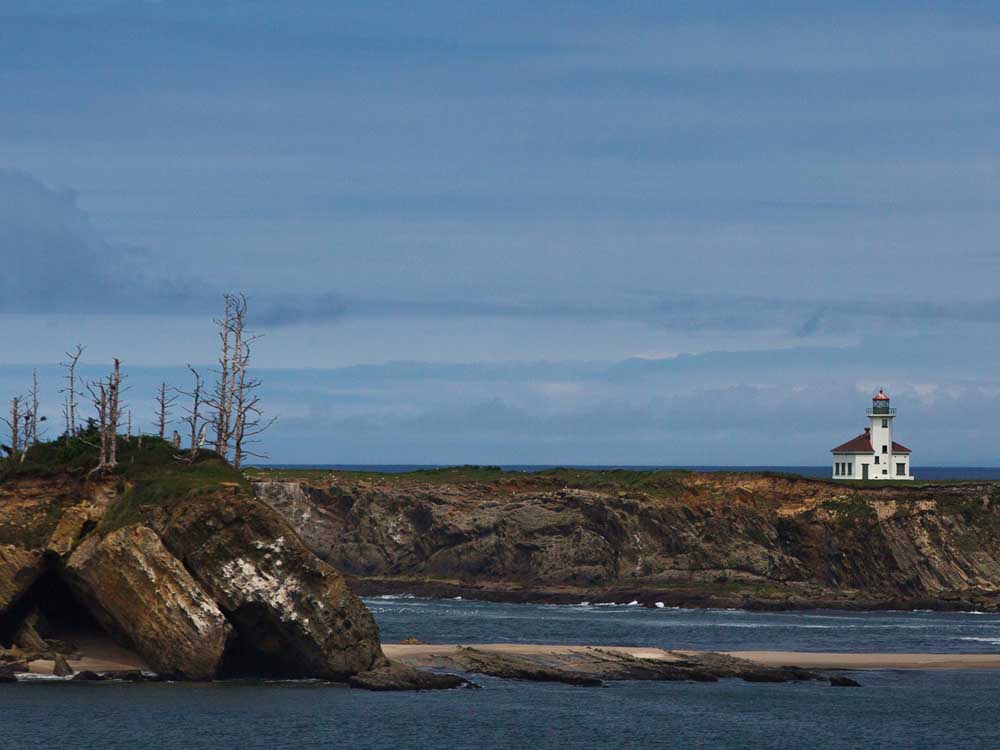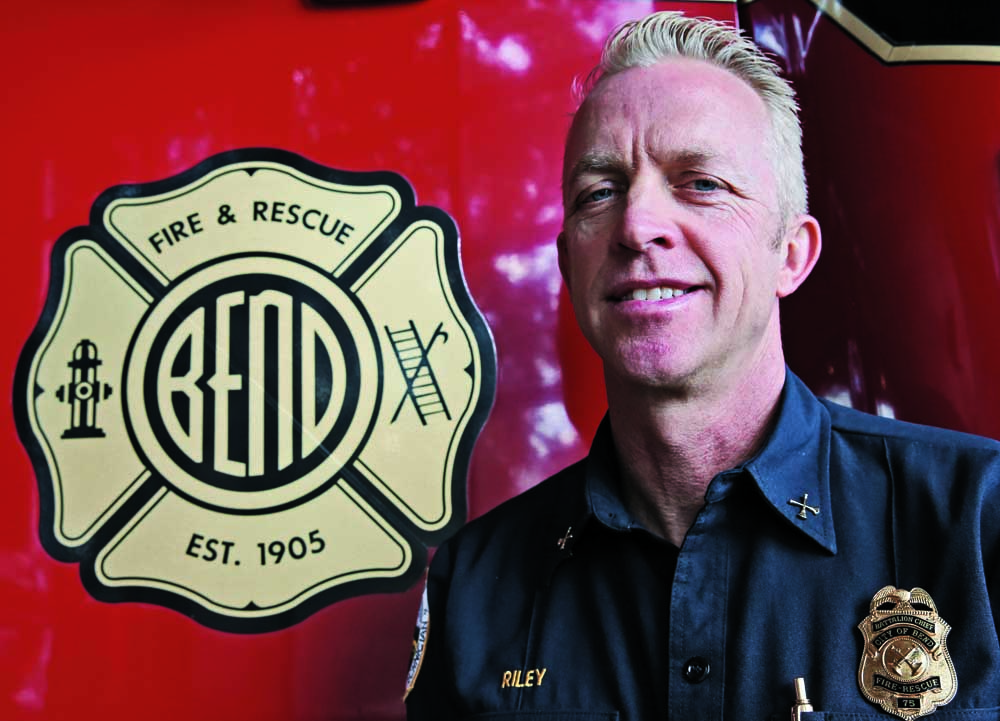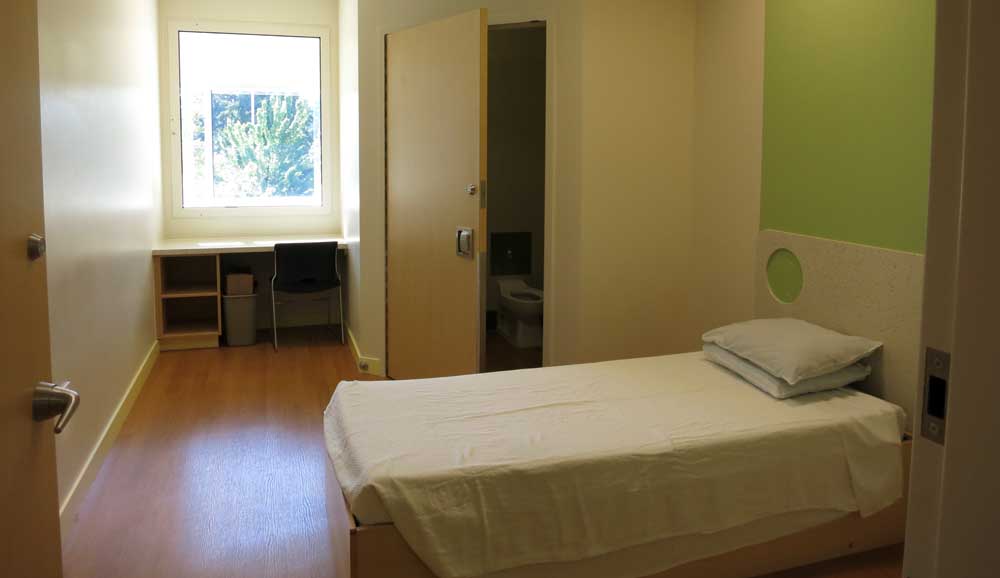Northwest Travel: Blues, Brews and Barbecue
Published 12:00 am Sunday, June 7, 2015

- Barb Gonzalez / For The BulletinOperational from 1934 to 2006, the historic Cape Arago Lighthouse sits on a desolate island connected to the mainland by a narrow causeway. On the nearby rocks of Simpson Reef, a variety of marine mammals, including sea lions, harbor seals and elephant seals, are often seen.
NORTH BEND —
What carnivore doesn’t love a barbecue?
The aroma of chicken, ribs and brisket, basted in savory sauces and slow-cooked for hours over charcoal or mesquite, teases one’s senses like a honeybee tickles a flower. When those smells mingle with maritime scents carried by coastal breezes from Oregon’s largest natural harbor, the result is an annual festival — in this case, BBQ, Blues & Brews by the Bay.
Held beside Coos Bay on Memorial Day weekend, and taking over the spacious south parking lot of The Mill Casino Hotel in North Bend, the 2015 event drew 39 barbecue specialists who came from as far away as Kansas City to compete for $13,000 in cash prizes.
With music by an Arizona blues band, and a beer garden that offered samples from 21 regional breweries (Three Creeks’ FivePine Chocolate Porter won the people’s choice award), the event drew throngs of local residents and coast visitors.
Learning how
My visit, accompanied by photographer Barb Gonzalez, wasn’t play. It was work: We were judging. Eating all that meat isn’t easy.
Our training was provided by the Kansas City Barbeque Society. During an intensive, three-hour, Friday afternoon certification course, we learned the do’s and don’ts of adjudicating, which we discovered was a very long way from the backyard grill.
We would be judging four basic categories of barbecued meats — chicken, pork ribs, pork shoulder and beef brisket — and scoring them for taste, tenderness and appearance. We were prepared in particular for things to look for in each category, even as scoring was weighted to make taste more important than the other two combined.
Yet taste, instructor Mark Simmons told us, “is very subjective and therefore very hard to teach.” He suggested keeping in mind the “five tastes”: sweet, sour, salty, bitter and umami, or savory.
Each of the meats was to be judged according to its own nuances. Chicken, for instance, can be white or dark meat, with or without skin — but the skin should be crispy and the meat moist. If there’s redness around the bone, the juice must be clear for a judge to be certain that it isn’t undercooked.
Pork ribs are cooked properly if the meat easily pulls away from the bone, but doesn’t fall off. Mushy is overcooked; anything less than tender is undercooked.
Pork shoulder, which typically is served either pulled (shredded), chopped or sliced, calls for the “top of the mouth test”: The meat should fall apart with little effort, but not dissolve, when one’s tongue forces it against the roof of one’s mouth.
With beef brisket (specifically not corned beef), a judge may administer a different test: He or she may pick up a slice and stretch it, to see how easily it pulls apart. Ideally, the meat will not fall apart, but will separate with little effort, indicating that it is tender but has retained its moisture.
In fact, judges were told to eat only with their fingers. Plastic forks were provided only for serving off larger plates. Yet a prime directive forbids finger licking! Paper towels and water are provided for cleanup.
Judges may not drink alcohol before or during the competition; they must not fraternize with barbecue teams nor consult with fellow judges for their opinions until after they have registered their marks.
How strict are the other guidelines? Here’s an example: Garnish and sauce are considered optional in presenting meats, but there are specific rules governing both. Green lettuce, parsley and cilantro are accepted as legitimate garnishes; kale and red lettuce, among others, are not, and will disqualify an entry. If sauce is used, it must have been applied directly to the meat, not served on the side. Again, this is grounds for disqualification.
Cape Arago
Training was Friday. The competition took place on Sunday. In between, Saturday afternoon was the big day for visitors, who paid just $1 per small taste from any and every barbecue tent.
But Gonzalez and I used Saturday to get away from the fragrant smoke and explore other pleasures of the greater Coos Bay area.
Our first stop was Cape Arago State Park, at the end of the 15-mile Cape Arago Highway running southwest from the urban centers. We timed our visit to coincide with low tide, when the tidepools of the rocky shoreline were fully exposed. Mint-green sea anemones, juice-purple sea stars and other denizens of the not-so-deep sheltered themselves in crevices while awaiting further protection from onrushing waves. Parents and children trod upon barnacles that encrusted the rocks, searching for glimpses of the tiny fish and crabs that skittered through the pools.
Larger creatures gathered offshore on Simpson Reef, a series of partially submerged rocks just a couple of miles north. At a roadside overlook, volunteer naturalists encourage visitors to use scopes for close-ups of California and Steller sea lions, harbor seals and a handful of elephant seals. Loudest are the California sea lions, whose barks may be heard for long distances, but the most intriguing are the giant elephant seals, so named for their prominent snouts. Although they breed on the central California coast, they haul out at Cape Arago for three weeks at a time to molt their fur and upper layers of skin — a necessary step in their growth to 2 tons in weight and 15 feet in length, we were told.
The overlook is within Shore Acres State Park, embracing the erstwhile 1920s estate of lumberman-shipbuilder Louis Simpson. At the heart of this park is a formal botanical garden, planted in such a manner that flowers are always in bloom. There are daffodils in late winter, rhododendrons and azaleas in spring, roses in summer, and dahlias in late summer and early autumn. And during the holiday season, more than 300,000 colored lights illuminate the early evenings.
There’s no visitor access to the nearby Cape Arago Lighthouse, which has a spectacular location on a desolate island connected to the mainland by a narrow causeway. But the view of the structure (operational from 1934 to 2006) is great from just south of Sunset Bay State Park, its beautifully framed crescent inlet a favorite of kayakers as well as overnight campers.
Between Cape Arago and Empire, Coos Bay’s west-end neighborhood, is the little town of Charleston, a working fishing community. The small harbor here is packed with trawlers and other vessels of all sizes. Harbor seals lounge on the docks where crab and tuna boats come to moor, while charter vessels welcome landlocked anglers who pay for a morning on the water.
Scheduled to open this summer is the new Charleston Marine Life Center, a project of the Oregon Institute of Marine Biology, a University of Oregon marine research and teaching facility that is just across Boat Basin Drive. The two-story aquarium-museum will have sections on marine ecosystems and deep-water species; on the evolution of whales and other marine mammals; and on the diversity of marine life, from giant squid to tiny worms.
Sights of Coos Bay
Another new museum is on the verge of opening its doors near downtown Coos Bay. The Coos History Museum, located on 4 acres where Front Street meets U.S. Highway 101, is a $5.3 million, 11,000-square-foot building with exhibit space, a research library and bookstore, a theater and a waterfront plaza for maritime demonstrations.
Museum Director Frank Smoot showed us through the color-coded exhibit galleries, designed to present a variety of interpretive “stories” from coastal, urban-tidewater and upland regions of Coos County. “We want the gallery space to be a trigger for cross-generational conversation,” said Smoot, a recent arrival from Wisconsin.
The new museum is scheduled to be operating on a full schedule by the July Fourth weekend, Smoot said. Admission will be $8 for adults, $6 for Coos residents, $4 for children, he said.
Smoot described the region as “pretty but gritty.” Indeed, Coos Bay (the largest town on the Oregon coast with 16,000 people) and North Bend (with 9,500 more) have always been blue-collar towns. Defined by the largest natural harbor between Seattle and San Francisco, the region was inhabited for thousands of years by the Coos and Coquille tribes.
The earliest pioneer settlements were established in the 1850s. By 1900, Coos Bay (the harbor, that is; the town was originally named Marshfield) had become an important shipping center for lumber and coal. By 1950, the coal mines had closed, but forest products carried the economy for decades more.
The town’s biggest attraction may be the Coos Bay Boardwalk. Beginning at the east end of Anderson Street in the heart of downtown, it extends for several blocks along the western edge of the historic waterfront. Interpretive plaques describe the bustle that occupied this corner of Oregon … especially after the completion of a railroad from Eugene (via Florence) in 1916. Until that time, it was much easier to reach Coos Bay by ship than by land: A stagecoach road from Roseburg, only 58 miles east, typically took 28 hours to negotiate.
A chainsaw-carved war memorial, installed in 2002, is at the heart of the boardwalk today. A historic wooden boat is displayed in another pavilion. A fleet of tugboats still lines up astride a wharf at the north end of the boardwalk, waiting to escort giant vessels to a wood-chips plant farther up-harbor, at the mouth of the Coos River.
In the waterfront plaza beside a new visitor center, a stylized monument pays tribute to the city’s favorite son, Steve Prefontaine (1951-1975), a famed distance runner and advocate for amateur athletes before his untimely death.
A couple of blocks away, the newly revitalized 1925 Egyptian Theatre reopened just under a year ago with its pharaoh-like art motifs touched up and repainted. We visited for a reprise of the 1980 John Belushi-Dan Aykroyd movie, “The Blues Brothers.” It seemed more than appropriate for presentation during the BBQ, Blues & Brews event.
Judgment day
To the north, The Mill Casino extends into the bay, marking the otherwise indistinct boundary between the cities of Coos Bay and North Bend. Owned by the Coquille (pronounced “KO-kwel”) Indian Tribe, this hotel-casino complex (incorporating an RV park) was opened in 1995 on the site of a former Weyerhauser Corp. sawmill and dock.
It was here that we stayed during our recent visit, here that we tackled our first major challenge as certified judges with the Kansas City Barbeque Society.
In fact, this was kind of a big deal for barbecue fanatics. Of hundreds of events each year in the United States and overseas, the KCBS (not the San Francisco radio station) sanctions only three annual competitions in the Pacific Northwest — the other two are in Renton, Washington, (the first weekend of April) and in Central Point (the last weekend of June) — so there was a lot of prestige involved for the winners.
We were assigned to separate tables of a half-dozen judges each. Treated paper “plates,” divided into six sections, served as the vessels from which we sampled each of the four types of meat submitted by the contestants. Each sample was coded. After taking a single bite (saving room for more), we picked up our scorecard and recorded a score that ranged from 9 (excellent; nothing is perfect) to 2 (inedible). A mark of 6 is considered average.
In fact, everything was better than average. I was not in the minority in scoring nearly every sample a 7, 8 or 9. These scores were added up by a special committee that deleted the worst of the six judges’ tallies for a final reckoning.
With two dozen filling bites of meat in our stomachs, we were then submitted to further torture: The BBQ, Blues & Brews organizers had added a macaroni-and-cheese competition. Three more samples were delivered to each judging table. At my table, mercifully, only one of the trio left me wanting a second bite.
An awards presentation honored the top scores in each category and presented a grand champion trophy to the competitor with the highest total from all meats. Overall honors went to Rooftop BBQ of Riverside County, California.
Our certification now enables us to work as judges at any KCBS-sanctioned event on the planet — including seven European countries and Australia. No, it doesn’t pay. But at least we know we’re well fed!
— Reporter: janderson@bendbulletin.com







